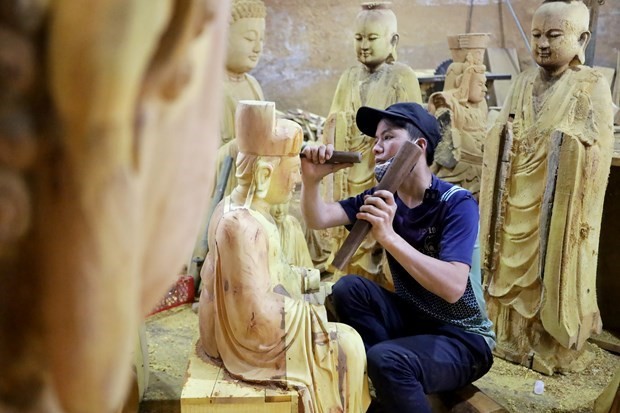
Ha Noi moves to develop agricultural, rural tourism
Latest
 |
| A worker carves a statue in Son Dong village of Ha Noi's Hoai Duc district. Son Dong village is known for making worship objects. (Photo: VNA) |
In this plan, each suburban district holding potential and advantages for agricultural and rural tourism will develop from one to three community-based tourism services or sites, with at least 50 percent of those products registered for intellectual property protection and recognised as three-star or higher products under the “One Commune, One Product” (OCOP) programme.
Each potential locality will build at least one agro-tourism connectivity model involving farmers, cooperatives, business households, and enterprises.
Besides, the city will provide training for at least 80 percent of the workforce at local tourism facilities and villages, officials in charge of tourism management, and other stakeholders in agricultural and rural tourism.
The municipal administration will develop six models of green and sustainable agricultural and rural tourism in the suburban districts of Thuong Tin, Dan Phuong, Thanh Tri, My Duc, and Thach That, as well as Son Tay town.
To implement this plan, authorities will conduct surveys to collect information about agro-tourism potential and the market while developing software for analysing statistics to serve tourism planning and management.
They will select and help develop community-based tourism destinations linked with traditional craft villages, along with some models of community-based tourism, agri-ecotourism, and culinary and cultural tourism.
To promote digital transformation in tourism, Ha Noi will form villages of smart agricultural and rural tourism, create software for managing and advertising tourism and agricultural products, and digitalise travel information centres.
The municipal People’s Committee has required localities to identify the existing rural tourist destinations, the ones that have received support, and those planned to be developed while clarifying those places’ advantages and difficulties, so as to give appropriate assistance.
Another important measure is to step up communications to raise public awareness of agro-tourism and new-style rural area building, and update local residents on tourism planning, legal regulations, and the code of conduct in public places.
According to Deputy Director of the municipal Department of Agriculture and Rural Development Ta Van Tuong, Ha Noi has 11 eco-agricultural farms operating under the model of education and experiential tourism, and four involved in agricultural tourism.
Many models of eco-agriculture in combination with tourism have generated high economic value, helping improve local residents’ living standards and income and give a facelift to rural areas.
Ha Noi is planning to bolster new tourism products based on the potential of each area, in a bid to gradually resume the entire tourism sector this year after the pandemic.
Apart from agro-tourism, other types such as resort and health tourism, community and spiritual tourism will also be prioritised in rural areas of the capital city.
This year, Ha Noi will focus on the domestic tourism market, taking this as the motivation for its recovery.
It is going step by step to completely resume tourism activities with the aim of welcoming 9 - 10 million visitors in 2022, including around 2 million foreigners, according to the municipal People’s Committee.
The capital city also set a target of earning 27.84-35.84 trillion VND (1.22-1.57 billion USD) from the industry this year.
Data from the Ha Noi People’s Committee showed that COVID-19 has taken a heavy toll on local tourism. The number of visitors to Ha Noi - all are domestic - totalled 4 million last year, plunging about 47 percent from 2020 and equivalent to just 36.3 percent of the yearly target. Tourism revenue nosedived some 59.8 percent year on year to 11.28 trillion VND.





















